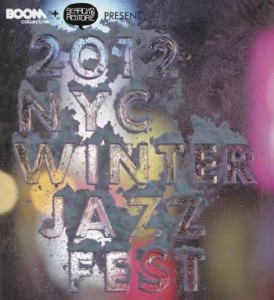Text by Sohrab Saadat Ladjevardi and Jim Hoey
 Now in it’s 8th year, NYC’s Winter Jazzfest sent out an impossible dare to city jazz fans this time in 2012: “Pay the low price of $45 for two nights and we dare you to try to see over 60 acts in four venues around the West Village”.
Now in it’s 8th year, NYC’s Winter Jazzfest sent out an impossible dare to city jazz fans this time in 2012: “Pay the low price of $45 for two nights and we dare you to try to see over 60 acts in four venues around the West Village”.
The clubs that featured bands are some of the oldest, and smaller, rooms in the city: Le Poisson Rouge, Sullivan Hall, The Bitter End, Kenny’s Castaways, and Zinc Bar. In trying to manically beat a path from spot to spot hoping to catch a favorite act, over 4000 music lovers made this year’s festival probably the most successful yet, thanks to the hard work of founders Brice Rosenbloom and Adam Schatz and the promotion efforts of Boom Collective and Search and Restore.
Since the closing of many of the more avant-garde downtown venues like Tonic and the original Knitting Factory, the city has felt a loss in the jazz scene; sure there’s always Lincoln Center, but what about the emerging artists, hungry to push boundaries? At times it’s felt like maybe the old “Jazz is dead” cliche is actually starting to ring true, with so much shifting sand under the feet of those in the scene, so to speak, and everything spreading out to Brooklyn. Here in NYC, that would be unbelievable, unacceptable.
At Winter Jazzfest this year, like it hasn’t in a long time, the buzz was back in the air, new sounds were blasting out of clubs that are more often than not taken over by tourists and bridge and tunnel crowds, and up-and-coming artists were sharing stages with long-established legends. The artists were even better off, after winning a landmark case that calls for a new revenue sharing model that gives them more cash for their efforts. For the younger, more fledgling groups, they had packed houses to play to, not a small thing for artists used to gigging around hungrily in a city with more musicians per capita than most other places in the world.
Since it’s held every year during the Association of Performing Arts Presenters (APAP) event uptown, that means hundreds of those music industry insiders are also in town getting to know acts that might be passing through the rest of the country at some point in the future. And since it’s still a small fest, at manageable venues, there wasn’t the overwhelmingly slick facade that you get with a lot of the larger, more popular fests that take place in NYC in the summer.
The first night, Friday, at Le Poisson rouge, John Medeski started it off, with an ambient, yet riveting solo piano, harmonium and bamboo flute performance, followed by the Nels Cline Singers (with Trevor Dunne on Bass and Yuka Honda on keys) who opted for a more minimal-ambient, progressive rock skewed approach. Over at Sullivan Hall we, here at DooBeeDooBeeDoo, also caught the New York Gypsy All-Stars for a set of incredible Balkan music, by way of Turkey and Lebanon, which featured intense clarinet and a singing bassist who swirled together multiple layers of Roma-inspired sounds.
Sketchy Black Dog and Adam Rudolph’s Moving Pictures played over at Zinc when we were able to get in (it was wall to wall), the first doing upbeat, kitschy, but quite proficient covers with a string section, followed by the latter, whose percussion-heavy world beats and improv lit the place up.
On Saturday, the powerful female saxophonist Lakecia Benjamin and her crew Soul Squad dove deep into jazz-funk and we were also lucky enough to make it to catch the Ravi Coltrane Trio doing a free take on modern jazz, without straying too far out. This trio featured Mathew Garrison, also the son of the famous bass player Jimmy Garrision who played with Ravi’s father on many classics.
Bernie Worrell and his Orchestra filled the stage for an epic funk jam, featuring Gary Lucas on guitar; later on another stage Shahzad Ismaily, Ches Smith, and Mat Maneri improvised in a minimally progressive jazz/rock vein with a folk touch, adding some noise here and there; Ben Williams and Sound Effect brought a massive hip-hop/ R&B blend into their sound, expanding and challenging further the expectations of the average jazz fan.
Cindy Blackman-Santana‘s Another Lifetime and Tyshawn Sorey‘s Oblique, with both masterful drumming techniques, were covering different ground but coming from the same roots. Oblique’s blending of modern and Western classical influences, and obvious composing and playing ability were particularly intense.
If you were an old jazz cat though, this Winter JazzFest might not have sounded like what you were expecting if you just came down from St. Nick’s in Harlem or over from the Village Vanguard or Blue Note. A highlight of the two nights was Marc Ribot‘s quip at the end of his set, “Oh yeah, this is a jazz fest”. Then he and his band Ceramic Dog launched into a bruised and battered version of “Take Five”, reminiscent of Hendrix and Charlie Christian and Cream all at the same time somehow. This spoke volumes about the rest of the artists as well, all who seemed on the verge of their own personal breakthroughs with respect to the traditions that they work out of and what visions they are trying realize. It also spoke volumes about what this fest is all about.

